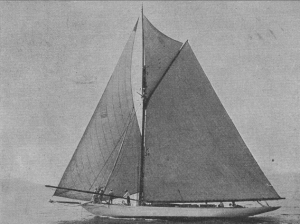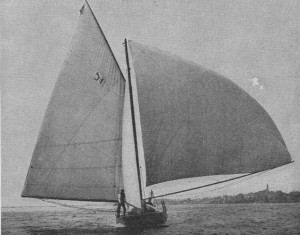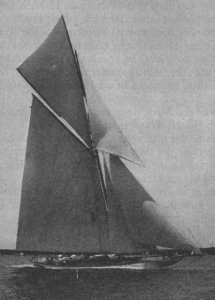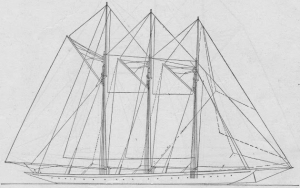Attention was first attracted to William Gardner by the wonderful qualities of the schoonerAtlantic, which won the famous race across the ocean of the same name, in 1905. While this race may have brought Mr Gardner popular recognition, it was the performance of his smaller yachts that stamped him as one of the leading naval architects of the world.

William Gardner, about whose life was little known, was born in Qswego, N.Y., on Lake Ontario. From his ninth to his fifteenth year much of his time was spent traveling and it was during these years that he made his first sea voyage. Entering Cornell University at the age of fifteen, he graduated about 1880. After leaving college his first position was with the Delaware River Iron Ship Building Co., then known as John Roach’s yard, at fitting, in the plate shop and foundry, acquiring a practical knowledge of the building of ships.
Good fortune led to his making the acquaintance of Gatewood and Bowles, American naval constructors who had not only been honor graduates of Annapolis, but who were the first American naval constructors to graduate from a foreign naval college. This association and the friendly advice of these two inspired Mr Gardner to go abroad to complete his studies, his chief desire being to follow the example of Gatewood and Bowles and obtain entrance to the Royal Naval College at Greenwich, England, a privilege confined strictly to government pupils. The instruction could not be had in any other way, so Mr Gardner obtained government employment and after many attempts, succeeded in being admitted to the Naval College.
At Greenwich he studied higher and applied mathematics and the fundamental principles of naval architecture. The lectures and studies were confined solely to the design and construction of warships, torpedo boats, destroyers and government vessels of war.
While there, he designed a battleship and a cruiser, making all the drawings and calculations. Mr Gardner also persuaded two great specialists (Reid and Jenkins, Lloyd’s leading authorities of structural strength in merchant ships) to give him private instruction. His summer vacations were spent in yachting and visiting the numerous shipyards, although his studies at Greenwich were not devoted to yacht designing, but to the science of naval architecture and shipbuilding.
The acquaintance of Fife, Watson and other leading yacht designers and many of the yachtsmen of England was of great value to him. After leaving Greenwich he went to Tyne and the Clyde, where he spent two years in practical work in the shipyards. Whenever the opportunity presented itself, trips to sea were taken, because he considered that no naval architect’s training was complete without personal observation of the action of vessels in use.
Mr Gardner and his fellow students were instrumental in having the admiralty adopt the practice of sending naval constructors to sea, a practice that was then adopted by the United States Navy.
In 1888, after returning to America, he established himself permanently in New York as a naval architect and his first order for a design was given to him in the fall of that year, by William Whitlock and C.W. Wetmore, for two 40 ft. waterline cutters, Kathleen and Liris. These graceful boats, of light construction, with long overhanging sterns and beautiful clipper bows, made a great name for the young designer.
The long years of study of construction and naval science gave him the knowledge necessary to design the hulls strong and powerful enough to carry their enormous sails. The confidence he had in his own work prompted him to guarantee the owner that Liris would win three out of five races against a fleet of ten boats. The accomplishing of this, and the fact that Kathleen, in her class, won practically every race she entered in the first two years, stamped Mr Gardner’s work with merits.
Mr Gardner’s next yacht of importance, the 90 ft. schooner Alcea, was raced in the United States and later sold to Germany, where she was renamed Nord Quest and won many prizes.
In 1895 the Norota was designed and built for Mr F.M. Hoyt, who in 1897 followed with another order for a 45 ft. cutter, the Syce. B.F. Wood built these and at the same time also built for an American yachtsman another boat (Kestral, designed by William Fife), to race against the Syce. The Syce easily defeated her rival and proved herself to be an almost unbeatable champion.

In 1896, between the time of Norota and Syce, he designed the steel schooner Quissetta, which had as her principle competitor, the Cary Smith schooner Amorita. Quissetta, although smaller, finally triumphed and won the championship, along with many of the season’s other prizes.
Although freak racing yachts were not of much interest to Mr Gardner, he designed, for Parker Brothers of Boston in 1898, the round bilge scow Cartoon, equipped with a narrow bronze fin and a dagger rudder. This boat, built to race in a 25 ft. cabin class, with the only restriction applying to the waterline length, was designed with a peculiarly light cabin the shape of an inverted mandolin.
The Cartoon was as extreme in both design and construction as the later inland lake bilge-board scows and was copied as a model for the class. She so outclassed all competitors, it was always regretted that she was not afloat for a longer time to show the speed she possessed. This was not possible because the lightly constructed racing freak was unfortunately dashed to pieces in a bad storm at City Island, N.Y., in 1901.

The success of the Mira, designed in 1899 for Charles Lane Poor, prompted Mr W. H. Ward in the year 1901, to commission Mr Gardner to design for him another 35 ft. cutter which was named the Dorwina, built by Wood, who also constructed the Mira. Dorwina was sailed by Wilmer and Addison Hanan, who won fourteen out of fifteen races the first season.
Another daring innovation in yacht construction was introduced in 1902, in the building of two bronze cutters, the Weetamoe for Senator Henry F Lippitt, of Rhode Island and theNeola, for Mr G.M. Pynchon, of New York. These two yachts were 85 ft. overall, only 51 ft. on the waterline and carried 5,000 sq.ft. of sail in a cutter rig. Weetamoe, was built entirely of bronze with bronze frames by George Lawley and Son, of South Boston. Neola had bronze plating, stem and stern casting, but her frames and deck beams were of steel. She was built at the yard of Townsend and Downey, Shooters Island, in the Kill van Kull, off Staten Island.
The racing between the two was very keen during the first season, Neola having a slight advantage until she lost her hollow mast in a squall, the replacing of which with a solid stick, lessened her stability somewhat and hurt her in a breeze. Weetamoe and Neola were designed under the old load waterline and square root of sail-area rule, which was then in use by the New York Yacht Club. In 1905, when a new rule, which was the forerunner of the Universal Rule, was adopted by the N.Y.Y.C., the Weetamoe and Neola, which had very flat sections forward and aft, had their bows changed to reduce their tax and also gain advantage of extra waterline.
In spite of the time allowance against them and the fact that they were old boats of another rule, with rebuilt bows and flat sterns, they were able, with equal skill in handling, to beat the new boats designed to fit the revised rule.

In 1905 the famous Atlantic (one of Mr Gardner’s greatest successes) which won from a fleet of the world’s largest and finest ocean-going yachts, the race from Sandy Hook to the Needles, for the famous ‘gold cup’ presented by the German Emperor. The Atlantic was designed for Mr Wilson Marshall and built by Townsend and Downey. Atlantic was 187 ft. long overall, 137 ft. on the waterline, a beam of 29 ft, schooner rigged with three masts. Auxillary power was furnished by a triple expansion steam engine and a water tube boiler, using fuel oil.
After completion, Atlantic, in the fall of 1903 was given a trial trip to the West Indies, In 1904 Atlantic won the Cape May Cup and also the Bretton Reef Challenge Cup.
Upon receiving word of the ocean race for the Kaiser’s Cup, Mr Marshall engaged the famous America’s Cup defender skipper, Captain Charles Barr and Atlantic was made ready for the coming event. She was taken to the Morse Iron Works at Bay Ridge, Brooklyn. All the internal ballast was removed because Mr William Gardner had decided that she should have an outside keel. Mr Mathew E. Fletcher, a skilled draughtsman from Mr Gardner’s office was given charge of the alterations. Careful measurements were taken and a keel pattern was made and from this pattern lead was cast and fitted to the bottom of theAtlantic’s steel keel.

This change improved the boat wonderfully and it is known to all yachtsmen down the ages how this yacht, after crossing the start line, was never passed and won the race in the record time of 11 days, 16 hours and 22 minutes, from Sandy Hook to Bishop’s Rock.
As mentioned above, the Kaiser’s Gold Cup was famous, but for all the wrong reasons. Initially promoted as a ‘Solid Gold Cup’, it was later discovered to be only gold plated.Atlantic’s glorious history is still revered, but not so the Kaiser and his cup!
The cutter Aspirant, designed for the Hanan boys, built by Wood and launched in 1903, was another great success. The Aspirant was 64 ft. overall, 40 ft. waterline, 11 ft. 8 in. beam, 9 ft. draught and was planked with mahogany, over bronze frames. This boat was handled in all her races by the invincible amateur skippers Addison Hanan and his brother Wilmer and in two years of hard racing lost but two races.
The ambition of every naval architect is to design an international cup defender, the defence of the America’s Cup being, of course, the greatest of all contests. But next to that came the Canada’s Cup and the Seawanhaka Cup, which were stepping-stones to international glory.

The Canadian challenger Strathcona, which was designed by Mr A.E. Payne of Southhampton, England and built by J. Andrews of Oakville, Ontario, Canada, had dimensions as follows: 59 ft. 6 in. overall, 40 ft. waterline, 13 ft. 7 in. beam and 8 ft. 4 in. extreme draught. The sail plans of both boats were of the conventional cutter rig and the design and construction of the boats were considered a credit to the designers and builders.Canadians, always crack sailors, challenged the Rochester Yacht Club, which at that time held the cup, won by the Genesee in 1899, for a race to be sailed in 1903. The New York Yacht Club commissioned Mr Gardner to design the Irondequoit, built by Wood of City Island, dimensions as follows: 65 ft. overall, 40 ft. on the waterline, 12 ft, 6 in. beam, 9 ft. draught and displacement 23 tons.
A. Emilius Jarvis, who had been the Canadian skipper in all the former Canada’s Cup races, was again at the wheel and the American Boat was in the charge of Captain James Barr, a professional from Long Island Sound. The first two races, were won by the Canadians because Barr and his crew were no match for the crack Jarvis and his seasoned veterans.
On the morning of the third race, two strange men were seen to board the Irondequoit.The professional captain was sent forward to look after the sails and two professionals of the crew were sent ashore. At the start the Irondequoit was in the windward berth and tack, luff, or try any trick he knew, Jarvis could not get out from under the Irondequoit’slee. The Irondequoit won this race and the two that followed, with the Hanan boys in charge, for they were the two strangers who had boarded the American yacht after she had lost the first two contests.
The next notable prize winner from the boards of Mr Gardner was the M boat, Gardenia: 60 ft. overall, 41 ft. on the waterline, 12 ft. beam, 8 ft. draught and carrying about 2,600 sq. ft. of sail under the rule in a cutter rig. She was designed for Mr A.H. Morris and built by Wood of City Island. Although built as a cruiser, she, under the skilled helm of Harry Johnson, was a notable prizewinner, easily defeating new boats built later to beat her. The record for one season alone was sixteen first places out of nineteen starts and the series prize at Larchmont. Gardenia was sold by Mr Morris to Leo S. Herzig of the Brooklyn Yacht Club and continued racing with Harry Johnson as her amateur skipper. She was later sold to a Canadian yachtsman and continued cruising and racing at the Royal Canadian Yacht Club of Toronto.
Information courtesy of www.abrushwithsail.blogspot.it









